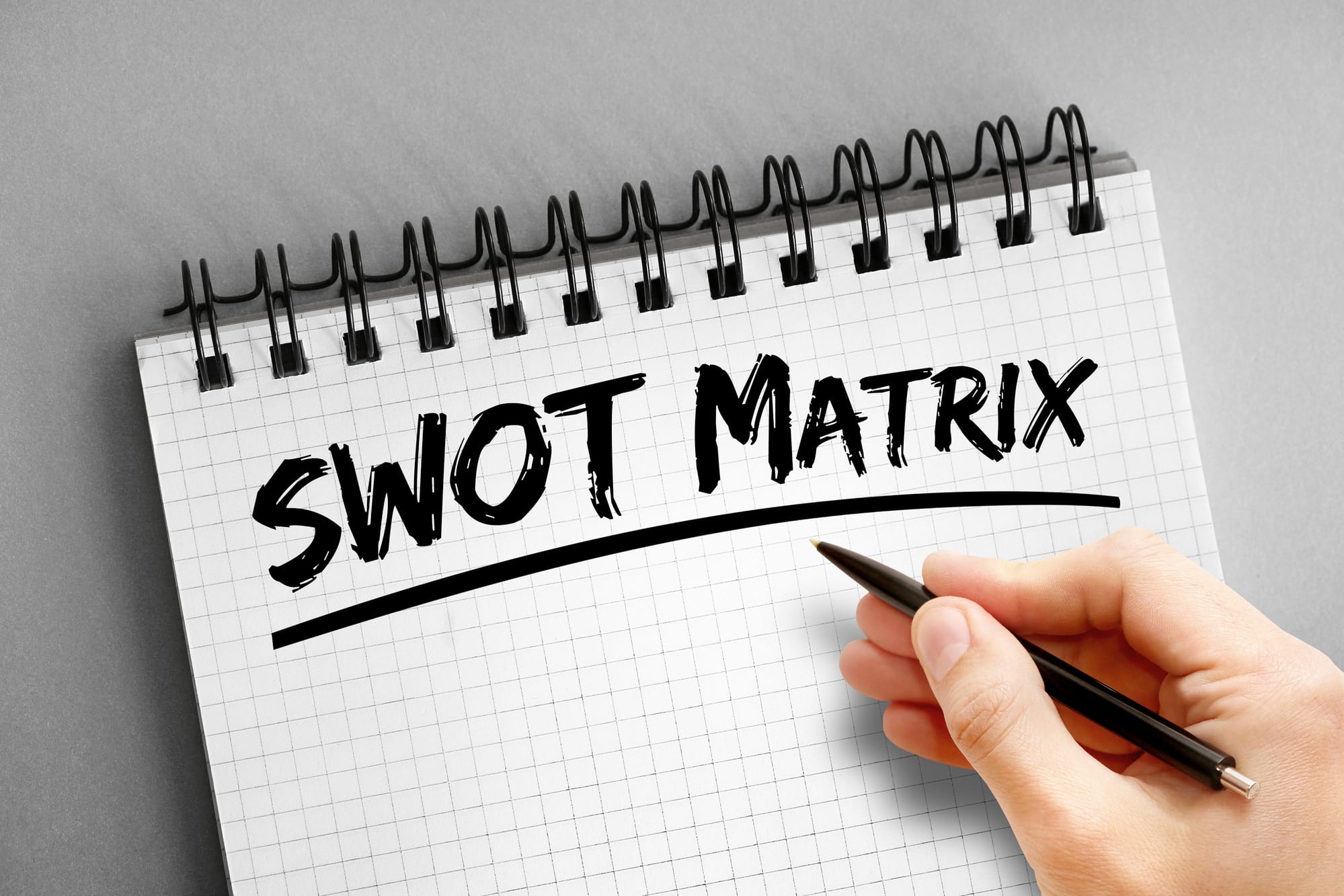The SWOT matrix is a business tool used to analyze companies, competitors, the industry businesses operate in, and even the country of the business.
Surely many of you might already be familiar with the infamous tool of SWOT analysis that is used to analyze different industries, countries, businesses, and organizations. But the SWOT matrix is not exactly as simple as it appears to be. In this article, we will try and understand the SWOT matrix in great detail.
For those of you who know how to conduct a SWOT analysis, you must already know that the SWOT is a simple, elegant, and powerful tool that can help shape the strategies of a company or any other entity being studied.
Before we get into the nitty-gritty, let’s first discuss what the acronym SWOT actually stands for. For those of you hearing of this for the first time, this acronym stands for strengths, weaknesses, opportunities, and threats. This broad classification of the four factors you see here basically is enough to cover all important aspects of the entity being analyzed.

SWOT Analysis
Here is a basic breakdown of what the SWOT consists of. It is important you understand this portion to make more sense of the SWOT matrix.
Internal and External Factors
The SWOT matrix is further classified into two categories of internal or external factors. The strengths and weaknesses together form internal factors whereas the opportunities and threats form the external factors.
Internal factors are the ones that can be controlled, initiated, and influenced by the internal parameters of the entity being analyzed. External factors on the contrary are the ones that are out of the influential capacity of the organization or the entity being studied; these factors are unprecedented and often arise when least expected.
You will understand better by reading ahead why these factors are classified the way that they are in the SWOT matrix.
Strengths
These are the factors that basically ensure that the entity being studied in the SWOT matrix is successful or has great value. Any factor which ultimately adds to the well-being and prosperity of the entity is going to be a strength.
Strengths are always the most sought-after out of the entire SWOT matrix because they build the entity to be competitive and sustainable.
Let’s take the example of a company. Suppose this company has excellent finances in terms of the revenue and profits it generates. This will definitely be a very big strength for the company because this was made entirely possible by the hard work done by the people within the company. As it is internal in nature, it is a strength.
Weaknesses
These are the factors that are basically what the entity tries to avoid because they take away from the strengths. Any factor which has the potential of harming the well-being, prosperity, or success of the entity will be its weakness.
Let’s take the example of the same company above. If the company has a limited set of products they offer, it is a weakness compared to other variants available because the company has direct control of this decision and can work on improving the product lines.
So you can see how weaknesses constitute internal factors of the organization in the SWOT matrix.
Opportunities
These factors are basically all possibilities available to an entity to avail so as to improve its existing conditions. Opportunities can be used to improve existing strengths, make new ones, and eliminate weaknesses by mitigating their effect if not by directly canceling them out.
If the company being discussed in the above mentioned two examples suddenly realizes that investing in more product lines will add to the company’s strength of having more revenue and will also get rid of the big weakness of lack of variety, the company should consider it as an opportunity.
Note that the opportunity has presented itself on its own and not because of the internal mechanisms of the organization. This is why opportunities are external factors in the SWOT matrix.
Threats
These are the factors in the SWOT matrix that essentially need to be avoided at all costs, however owing to their external nature; the entity cannot simply escape them at will.
Threats need to be mitigated either by amplifying existing strengths so that their effect is not as severe or by cashing on the opportunities available so that the company or entity has more pros than cons.
Continuing on the above example, the company in question surely has competitors. Where do these competitors exactly come from? Yes, you got it, on their own because one can’t simply stop other players from entering the industry. This is why competition serves as a very big threat for any company.

Why is it Called SWOT Matrix?
The SWOT or as we are calling it in this article the SWOT matrix is basically a tabular format that contains four divided sections for each factor so that individual points can be jotted down in each category. It consists of a 2X2 grid that divides the matrix into the four compartments needed.
Although you don’t necessarily need the SWOT matrix to work on the analysis, it makes the work of compilation and accumulation extremely simple. Instead of writing huge sentences for every piece of finding during the research phase, you can simply note down the important points in the SWOT matrix and call it a day.
Not only that, but the SWOT matrix also makes it very easy to contemplate the use of the stated information as well. When you have all the factors mentioned precisely and clearly in the SWOT matrix, you can make better decisions using the data.
You know exactly what opportunities are the ones you want to capitalize on and you know the strengths that might be amplified because of this decision or consequently the weaknesses that can be nullified. It gets the creative juices flowing in the brain so you can immediately put the SWOT matrix to good use.
Now imagine that you do have the research, but if it is written in an uncoordinated fashion, it won’t be as easy to make good use of it as compared to the method discussed above.

Who Can Use the SWOT Matrix?
Well, the SWOT matrix also is a business tool most often used by business people to analyze their companies, competitors, the industry they operate in, and even the country of the business.
It is a great tool to see which places present them to be better business investment targets for internationalization decisions. It can also help people understand exactly where their own company stands in terms of the progress they are making and the setbacks they have.
The SWOT matrix highlights clearly the points of improvement so the company may be able to improve its performance.
That being said, anyone who is anyone can make use of understanding this matrix. People of all ages but especially students should be accustomed to how a SWOT matrix can be built from scratch and the benefits it can bring. Because even if these students don’t want to become entrepreneurs or business personnel, chances are they will still be a part of some company as employees.
Having the knowledge of the SWOT matrix will only aid them in making better and more informed decisions that go to support the overall mission and vision of their respective organizations.
Many jobs actually require employees to be able to draw out SWOT matrices for various situations the company might be in.
In such fast-paced environments, you don’t have the luxury of time to be able to pen out a detailed analysis; instead, you are supposed to be able to jot down the researched material quickly in the SWOT matrix so that you save time.
Why Do We Need the SWOT Matrix?
Well, a SWOT matrix can help highlight some factors which might seem very apparent and in your face, but there is a lot in this information that can easily be overlooked and hence missed.
When key stakeholders of the company are unaware of how all of these factors are shaping everything up, they can only do so much. In order to make educated and calculated decisions that will add more to the company’s future instead of taking away, the SWOT matrix is absolutely needed.

Example of SWOT Matrix
You can surely find many such examples swarmed all over the internet, but just so that this article serves the purpose of explaining to you what a SWOT matrix essentially is like; here is a brief SWOT analysis for Apple.
Keep in mind the points noted down here are very generic and only so because this is an example and not an actual SWOT for the company; that would be very detailed (in fact, you can check our comprehensive Apple SWOT analysis).
| Strengths - Brand Equity. - Sales Revenue/Profits. - First Mover’s advantage. - iPhone as the best-selling product. | Weaknesses - Product Lines are not as diverse as they could be. - Very expensive to own their products. |
| Opportunities - They can venture out into making autonomous vehicles. - They can venture out to make their own internet platform. | Threats - Apple has many competitors, the most prominent being Huawei and Samsung. - Technological trends change exponentially vastly, making the industry very dynamic. |
So now that you have a quick SWOT matrix for Apple above, you can clearly tell how much time it was possible to save by having all the findings noted in an orderly format. This is exactly how you are supposed to draw SWOT matrices should you ever need to.
This way, you can easily see what the company is doing currently which does them favors and what it is they need to do differently that might be harmful either in the present or in the future.

SWOT Matrix: Final Word
If you have read your way right down to this very point then you are definitely an expert of the SWOT matrix. Exaggeration aside, you definitely know more about the humble SWOT tool and how using it in the form of the SWOT matrix is beneficial.
In this article, we have not only gone through what a SWOT essentially is, but we have also seen how each factor is further categorised as either internal or external and how it is important to know the distinction between the two.
We have also gone through each and every factor individually using a generic example to make sense of how it ultimately contributes to the SWOT matrix. In the end, we have also sketched out a basic SWOT matrix using the 2X2 grid to know how it works in this format.
By using the example of Apple, a company well known by anyone who might be reading this, we wanted to ensure you understand the difference between the concept of internal and external factors.
So now that you are done, you can always look at more types of the SWOT matrix applied to other companies across the internet to know more. There are plenty of templates available as well if you want to practice making the SWOT matrix.
With this we leave you more knowledgeable and on your way to work on your own SWOT matrix. Good luck to you!


